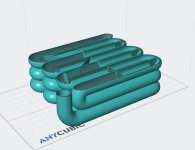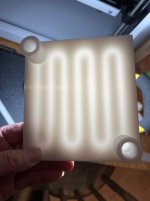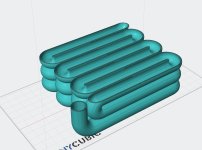You are using an out of date browser. It may not display this or other websites correctly.
You should upgrade or use an alternative browser.
You should upgrade or use an alternative browser.
Heat Exchanger with spline path
- Thread starter Britt007
- Start date
Britt007
0
I've noticed H-EXCHG Unit Front .. U-Units right and U-Units left are not showing a shell, and when sliced shows lots of artefacts in Anycubic Photon Workshop* Also note that all shell modifiers in the hierarchies have moved to to the top. The sequence of nodes in the object browser can make or break the modification of a mesh.

Britt007
0
Britt007
0
Hi, this heat exchanger will be resin printed and subject to non ionising radiation, the resin is invisible to the radiation so will have no effect upon it, but the heat transfer fluid in the heat exchanger it will, that's why the tubes are stacked closely together, the heat exchanger will be inside a tightly fitted radiation chamber for maximum efficiency from the radiation, this heat exchanger will be feeding another one close by made of copper with gaps between the tubes and sitting in a resin printed box filled with water that flow in and out, so the copper heat exchanger will transfer its heat to the water, I will be making these tubs a lot smaller so there is a lot more tubes making the fluids journey through the heat exchanger longer, exposing it to the radiation longer, I will be making many different design prototypes, by the way love the arrow animation.It occurred to me if your tubes are resting on each other nothing can flow between
them resulting in very little heat exchange, unless I misunderstand the design.
View attachment 39785
And again thanks everyone for the help, much appreciated.
Britt007
0
Hi,Sometimes a project gets stuck in my head and it occurred to me,
you could subtract a square path through a solid block
to maximize the fluid volume and exposure.
View attachment 39798
Thanks again for you input.
I have already experimented with this design but I think as there is slightly more material it absorbs more radiation than the standard model so is less efficient.



